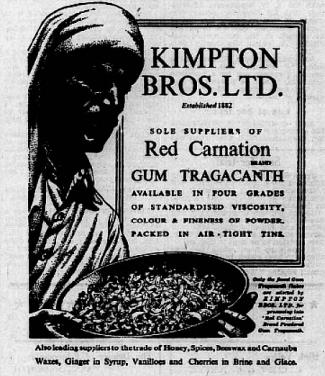

|
 What's in our food? All sorts of stuff, and the addition of little touches of this and that is not by any means new. The European system of 'E-Numbers' may look rather alarmingly new, but is just a formal way of identifying the things you may find in your food, many of which have been in use for centuries, as this list shows...  Advertisement for food additives, 1930's E503 Volatile, Volatile Salts, Sal Volatile..., Salt of Hartshorn..., Baker's Ammonia Traditionally made by processing deer horns, hence the name 'salts of hartshorn', Ammonium Carbonate degrades with heat into ammonia gas and carbon dioxide and was used as a quick leavening agent before the introduction of baking soda and baking powder. E413 Gum Dragon..., Gum Tragacanth..., Shiraz Gum, Shiraz, Gum Elect Known in England at least since the 16Cent, a natural gum obtained from the dried sap of several species of Middle Eastern legumes of the genus Astragalus. Gum tragacanth is used to stiften the paste used in floral sugarcraft. Astragalus flowers of the plant which gives E413 Image: "Ciar" E420 Sorbitol A form of sugar-alcohol first discovered in the juice of mountain ash (Sorbus) berries in 1872. It is now mostly made from sweetcorn but is also found in the fruits of apples, plums, pears, cherries, dates, peaches and apricots. E414 Gum Arabic..., Acacia Gum, Chaar Gund, Char Goond, Meska A stabiliser containing glycoproteins and polysaccharides. A natural gum made of the hardened sap of two species of acacia tree found in Senegal and Somalia. Sanders Powder A red colouring powder containing santalic acid made from the Indian red sandlewood tree. E252 Saltpetre... or Sal Prunella... Potassium nitrate. Similar to common salt, and similarly used as a food preservative at least since the 12th Century. Called 'Sal Prunella' when in a solid form - formerly thought to be a different chemical. E172 Bole Armenia..., bolus armenus or bole armoniac A form of iron oxide in an earthy clay found in Armenia, used as a brown colouring. It is traditionally used, among other things, to make 'red' herrings, red. E501 Potassium carbonate, pearl ash, salts of tartar... Historically, pearl ash was created by baking potash in a kiln to remove impurities. The fine, white powder remaining was the pearl ash. The first patent issued by the US Patent Office was awarded to Samuel Hopkins in 1790 for an improved method of making potash and pearl ash. In late 18th century North America, before the development of baking powder, pearl ash was used as a leavening agent in quick breads.  |
|
MORE FROM Foods of England... Cookbooks ● Diary ● Index ● Magic Menu ● Random ● Really English? ● Timeline ● Donate ● English Service ● Food Map of England ● Lost Foods ● Accompaniments ● Biscuits ● Breads ● Cakes and Scones ● Cheeses ● Classic Meals ● Curry Dishes ● Dairy ● Drinks ● Egg Dishes ● Fish ● Fruit ● Fruits & Vegetables ● Game & Offal ● Meat & Meat Dishes ● Pastries and Pies ● Pot Meals ● Poultry ● Preserves & Jams ● Puddings & Sweets ● Sauces and Spicery ● Sausages ● Scones ● Soups ● Sweets and Toffee ● About ... ● Bookshop ● Email: editor@foodsofengland.co.uk COPYRIGHT and ALL RIGHTS RESERVED: © Glyn Hughes 2022 BUILT WITH WHIMBERRY |